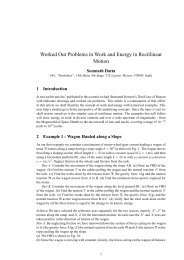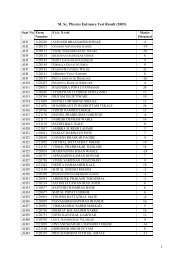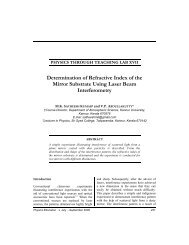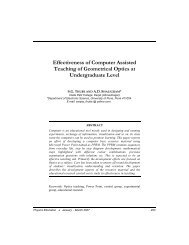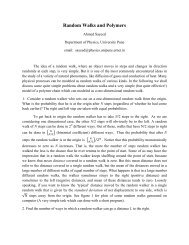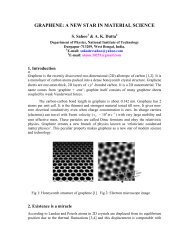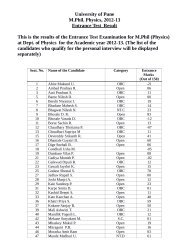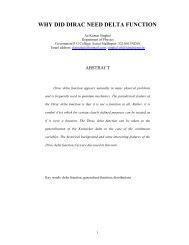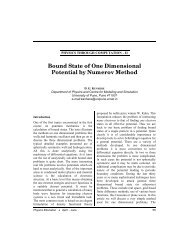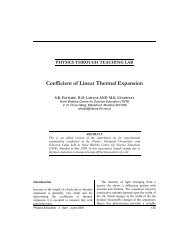Newton's Third Law of Motion
Newton's Third Law of Motion
Newton's Third Law of Motion
You also want an ePaper? Increase the reach of your titles
YUMPU automatically turns print PDFs into web optimized ePapers that Google loves.
to appreciate the principles <strong>of</strong> mechanics,<br />
the forces and how they guide the motion<br />
<strong>of</strong> objects, without drawing FBDs.<br />
4. Add up vectorially all the external forces<br />
acting on the system. In some cases this<br />
vector sum may be zero. In that case a<br />
central point <strong>of</strong> the object, called the<br />
Centre <strong>of</strong> Mass, to be abbreviated as CM,<br />
will be either stationary or moving with<br />
constant velocity (i.e., constant speed<br />
along a straight line.)<br />
We shall refer to the motion <strong>of</strong> the CM as<br />
the bulk translatory motion <strong>of</strong> the system.<br />
If the vector sum <strong>of</strong> the external forces is<br />
non-zero, then that vector sum F total will be<br />
called the Resultant Force on the system.<br />
The bulk translatory motion <strong>of</strong> the system<br />
is determined by Newton’s second law <strong>of</strong><br />
motion, which can now be written as<br />
M r = F total (2)<br />
where M is the total mass <strong>of</strong> all the component<br />
parts <strong>of</strong> the system, and r is the radius vector <strong>of</strong><br />
the CM <strong>of</strong> the system, so that r is the<br />
acceleration <strong>of</strong> the CM.<br />
We have illustrated Rules 1,2,3 in Figures<br />
1. In the Top Box we have shown three objects<br />
A, B and C interacting with one another, and<br />
forming a system. We assume that this system<br />
<strong>of</strong> three objects is not subjected to any<br />
“external force”. Individually the objects A, B<br />
and C are moving and accelerating only due to<br />
the forces <strong>of</strong> interaction among themselves.<br />
In frame (a) we have depicted each one <strong>of</strong><br />
them as a single system, by drawing<br />
boundaries (with dotted lines) around each.<br />
The forces <strong>of</strong> interaction are (F 1 ,F′ 1 ), (F 2 ,F′ 2 ),<br />
(F 3 ,F′ 3 ). The pair <strong>of</strong> forces within parentheses<br />
are the “equal and opposite” action-reaction<br />
pairs. For example if F′ 1 is the action force,<br />
then its counterpart F 1 is the corresponding<br />
(equal and opposite) reaction force. Similarly if<br />
F 3 is the action force, then its counterpart F′ 3 is<br />
the corresponding (equal and opposite) reaction<br />
force. Note also that we have drawn “shooting”<br />
lines on each one <strong>of</strong> the three objects indicating<br />
that the objects are all moving objects having<br />
velocities v a , v b , v c respectively.<br />
Each one <strong>of</strong> the three systems A,B,C is<br />
subjected to the following external forces:<br />
(1) external forces F 1 ,F 2 on A;<br />
(2) external forces F′ 1 ,F′ 3 on B;<br />
(3) external forces F′ 2 ,F 3 on C.<br />
In frame (b) we have clubbed A and B<br />
forming a single system AB. Now it is an<br />
interaction between two systems namely, AB<br />
and C. The only external force on AB is F′, and<br />
the only external force on C is F = −F′.<br />
In frame (c) we have taken A, B and C<br />
together as a single system ABC. There are no<br />
external forces on this system ABC.<br />
We shall now illustrate Rule 4 in the form<br />
<strong>of</strong> the following equations <strong>of</strong> motion.<br />
System Net external force on the system Eqn <strong>of</strong> <strong>Motion</strong><br />
A F total = F 1 + F 2 m a ra<br />
= F1 + F 2<br />
B F total = F′ 1 + F′ 3 m b<br />
rb<br />
= F′ 1 + F′ 3<br />
C F total = F′ 2 + F 3 m c rc<br />
= F′ 2 + F 3<br />
AB F total = −F = −(F′ 2 +F 3 ) = F 2 + F′ 3 (m a +m b ) r ab<br />
= F′=−F<br />
ABC F total = 0 (m a +m b +m c ) r abc<br />
=0<br />
(3)<br />
222 Physics Education • July − September 2009




